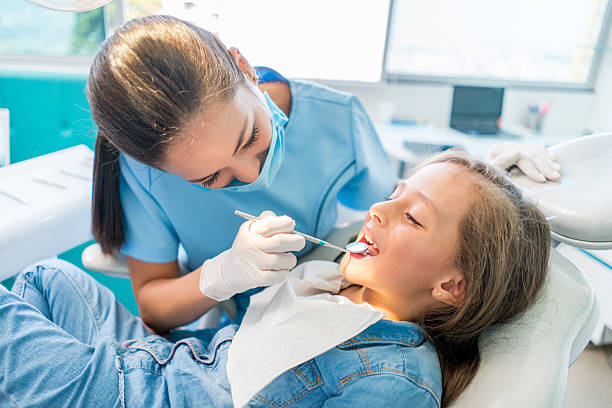With more and more people concerned about their dental health and looks, individuals are looking for a variety of dental services in Sturbridge Invisalign teeth bleaching, and professional cleaning. This trend is even seen in kids as parents are looking for better dental hygiene for their children, as a result, in cities like Sturbridge Invisalign for kids and appointments with pediatric dentists have taken a leap.
When it comes to whiter and shinier teeth, most of us are worried about teeth staining and how to get rid of it. So we have put together the important details for you. As per the dentists, teeth staining happens for many reasons, including your food and choices of drink, your oral hygiene, and medication use. Teeth stains particularly occur on the surface of the tooth or below the tooth enamel and some individuals also tend to develop both types of teeth stains.
Types Of Teeth Stains
According to experts in Sturbridge, Invisalign Teen Treatment and professional dental cleaning services have seen quite popularity over the past few years. They suggested that tooth staining can occur as a result of surface stains and this happens due to actual changes in your tooth material or it can be because of a combination of both the factors. Dental professionals have classified three main categories of tooth staining:
- Extrinsic Teeth Staining:
The extrinsic tooth stain is a staining on the surface of the tooth. It generally occurs when stain particles including pigmented residue from food or drink builds-up in the film of protein that covers the tooth enamel. Extrinsic tooth stains are potentially caused by tobacco use or by regular drinking of coffee and tea, wine or cola drinks. This type of tooth stain responds well to regular Orthodontic cleaning and brushing the teeth with whitening fluoride toothpaste.
- Intrinsic Teeth Staining:
The intrinsic tooth stain is the staining below the surface of the tooth. As per an expert dentist near me, this type of staining particularly occurs when stain-causing particles work through the exterior of the tooth and finally accumulate within the tooth enamel. Excessive use of has also been associated with intrinsic staining especially in children. An intrinsic tooth stain is difficult to remove, but it can be done and may require bleaching using professional or at-home chemical teeth-whitening products, for example, White strips.
- Coming of Age Teeth Staining:
Age related teeth staining combines the results of both intrinsic and extrinsic tooth stains. This happens because the core tissue of your teeth, the dentin, naturally grows in pale yellowish color over time and thus teeth discoloration occurs as we age. Also, the enamel that covers the tooth becomes thinner thus allowing the dentin to show through. These intrinsic causes of Staining combined with extrinsic causes such as the effects of certain foods, beverages, and tobacco will eventually cause most adult teeth to stain with age.
Foods and Drinks To Avoid
- Tea: Tea is an amazing drink but it may not be the best choice for keeping your teeth pearly white. Dentists say the brew present in the tea, especially the basic black variety, tends to cause more stains than coffee. Herbal and white teas can wear away the outer covering of your teeth also known as enamel thus causing stains.
- Sauces: Sauces and ketchup may be tasty, but deeply colored sauces such as soy, tomato, and curry tend to cause stains. It is advised to switch to light-colored or creamy sauces meanwhile brush and rinse soon after eating.
- Sports Drink: Acidic foods and drinks can also negatively affect your teeth. Sports or energy drinks can erode outer covering known as enamel thus setting the perfect stage for stains. Drinking water or oral rehydration solution during workouts is a much better choice.
- Wine: If a food or drink like wine can stain a tablecloth then it can stain your teeth too. Thus there is no surprise that red wine, the acidic drink known for its dark and rich color, will eventually discolor your teeth. However white wine, which has even more acid, can also stain your teeth.
- Fruits and Berries: Blueberries, blackberries, cherries, pomegranates and other vibrant fruits can also stain your teeth. So is the case with the juices and pies made from them. Paler fruits such as white grapes and white cranberries will cause less stains. But they do also carry acid that can soften and weaken your enamel.
- Sodas, Cola and Other Carbonated Drinks:Thanks to acids and dyes because these drinks However even the light-colored ones can eventually lead to serious staining. In addition, the chemicals that add flavor can also erode away your enamel.
- Candies and Sweets: If your favorite food is hard candy, chewing gum or a Popsicle that can make your tongue change its color, then it might also stain your teeth. The good news is that unless you eat these sugary items often, they probably wouldn’t do much harm.
Bottom Line:
Simply eating these foods will not transform the color of your teeth and mouth. And it is still important to limit tooth-staining foods and practice better oral hygiene. In addition, you can also try other natural remedies such as baking soda or hydrogen peroxide. If you are still worried about the shades of your teeth, we recommend consulting with a dentist near you to get that beautiful-looking smile you have been longing for.

